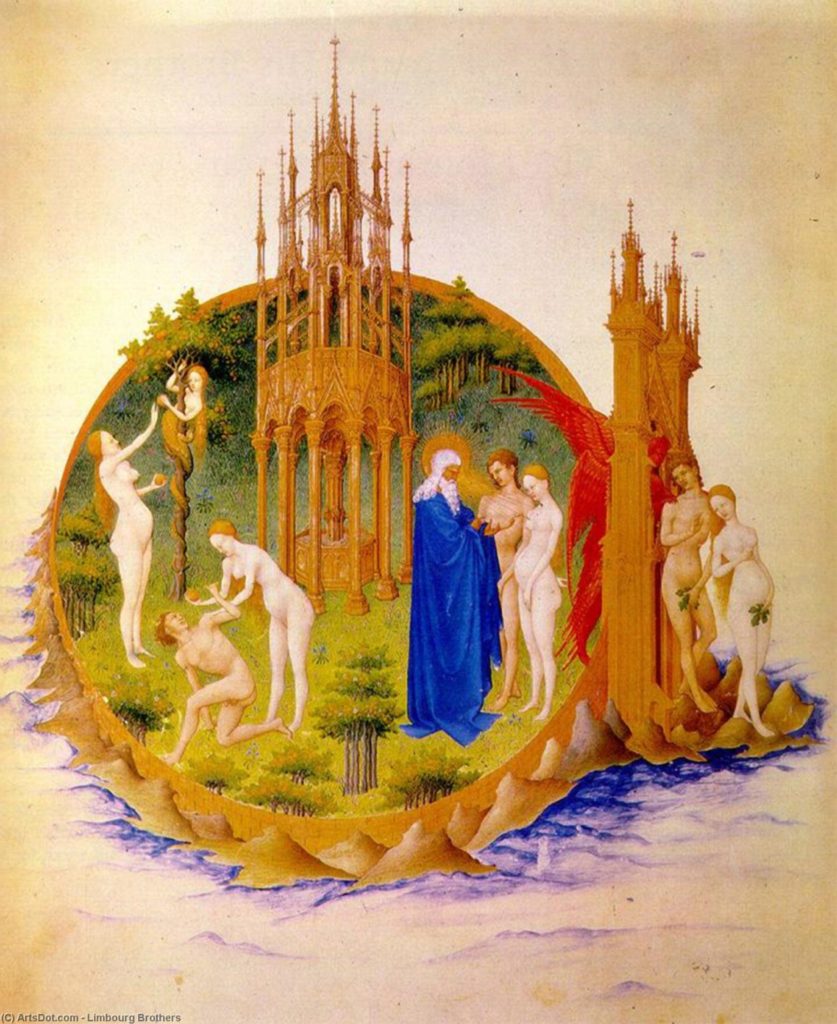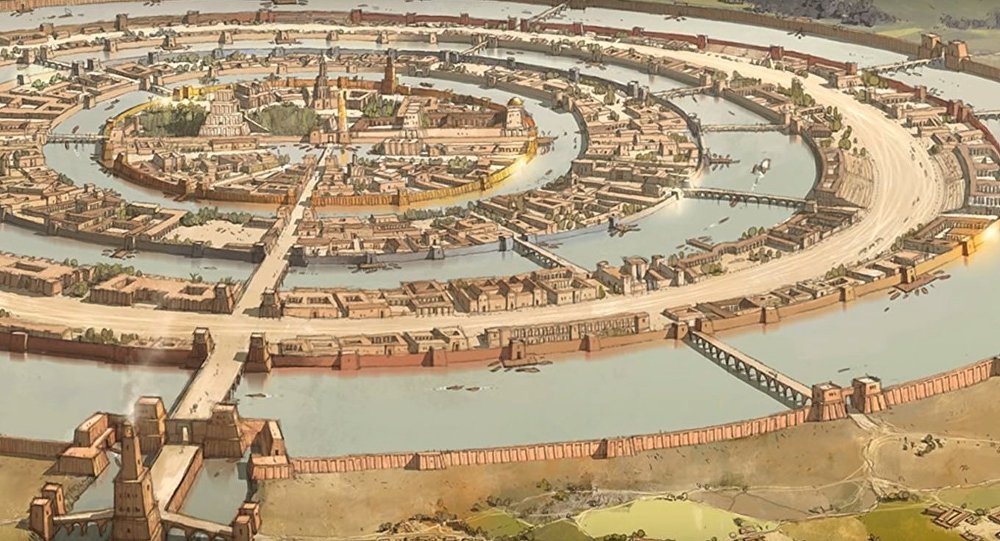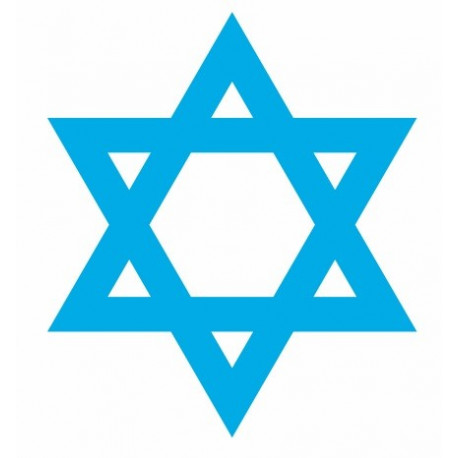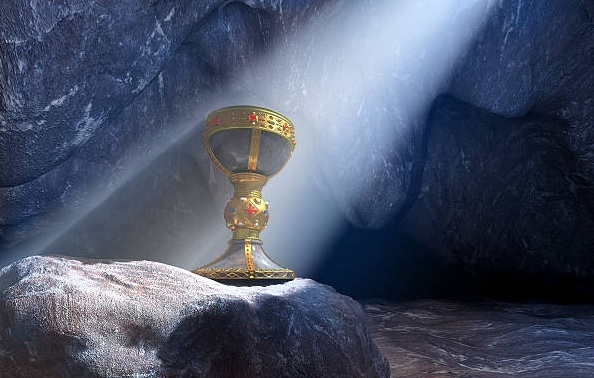In the narrative of Genesis, we find traces of a universal myth with prehistoric origins, depicting a land rising from primordial waters. This land becomes a mountain, a paradise from which four rivers flow. It also speaks of a tree, a serpent, and much more…

“The Lord God planted a garden in Eden, in the east, and there He placed the man whom He had formed. The Lord God caused to grow out of the ground every tree that is pleasant to the sight and good for food; the tree of life also in the midst of the garden, and the tree of the knowledge of good and evil. A river flowed out of Eden to water the garden, and from there it parted and became four heads. The name of the first is Pishon; it is the one which skirts the whole land of Havilah, where there is gold.” (Genesis 2:8-11)

According to statements by Aristotle reported by Flavius Josephus, “the Jews descend from Indian philosophers. They say that the philosophers are called Kalano in India and Jews in Syria, after their residence; for the place they inhabit is called Judea.” It would be more accurate to say that Judaism contains elements borrowed from the ancient traditions of the Indian subcontinent.

History books address very little the civilization of the Indus Valley, in contrast to, for example, those of Mesopotamia or Egypt. However, it dominated a territory of about one million square kilometers for 700 years. It had its own writing system and practiced large-scale irrigation.
Its inhabitants traded with Mesopotamia (notably the south) and the Middle East, where excavations have uncovered numerous gemstones originating from the Indus Valley.

The unique feature of the Indus Valley civilization is that, despite having all the characteristics of a unified state, it seems to have had no central political-religious organization. Excavations have not revealed any forged weapons. There are no signs of wars. Everything was based on cooperation, not confrontation.
“Garden of Eden” is called “Gan Eden” in Hebrew.
גן עדן
In Sanskrit, “Edhini” (एधिनि) means “Earth.”
In the beginning, according to Vedic hymns, there was neither Heaven nor Earth. Everything was in a state of Asat, or Non-Being. From the Primordial Ocean (“Apas”) emerged a piece of land that eventually became a mountain.
In Asia, this mythical mountain is called Mount Meru (in Sanskrit: मेरु, also called Sumeru with the honorific prefix “Su”).

In Hindu, Jain, and Buddhist cosmology, Mount Meru is considered the highest point in the world, where Heaven and Earth converge. It is the axis of the physical and spiritual universe, above which the North Star shines. According to the Vishnu Purana, it has seven levels and is the dwelling place of the souls of the dead. Its summit is the abode of Brahma, the 33 deities, and the four guardians of the cardinal points.

In the name of Mount Meru, we find the Indo-European root “Mer,” which means “to shine,” “to sparkle,” as in the Sanskrit “Marici” मरीचि (“ray of light,” “sparkling”) or “Murmura” मुर्मुर (“dying ember”). The root “Mer” gave rise to the derivative “Mori,” meaning “to die,” “to disappear,” which is, for example, the origin of the Latin “Mors” / “Mortem,” which gave rise to the French “Mort.” “Mer” also led to “Mare” in Latin and then “Mer” in French.
In Hebrew, “Meïr” means “illuminating,” “luminous.”
מאיר
Meru
מרו
Classic gematria = 246
The first word of the Bible with a gematria of 246 is “Lehaïr” (“to illuminate,” “to light up”)
להאיר
“And let them be for lights in the firmament of the heavens to give light on the earth. And it was so.” (Genesis 1:15)

Many Buddhist, Jain, and Hindu temples have been constructed as symbolic representations of this mountain.
The central tower of the Angkor Temple symbolizes Mount Meru.
The “Throne of Sumeru,” “Xū Mí Zuò” ( 須彌座 ) is a common feature of Chinese pagodas.
The apex of the pyatthat, a multi-tiered roof typical of Burmese religious and royal architecture, also represents Mount Meru.

The sacred texts of India, including the Mahabharata, celebrate the gold of Mount Meru, from which four rivers spring, as in the description of the Garden of Eden. The slopes of Mount Meru are described as golden to the East, silver to the West, crystal to the Southeast, and agate to the Northwest.

The Himalayan range is the center that lies to the north, the “North Pole” of the Indian subcontinent.

Rivers flow from the Garden of Eden. We can thus assume that it is a high place, a mountain as the prophet Isaiah speaks of: “the mountain of the meeting (of the gods), in the depths of the North.” (Isaiah 14:13)
The same goes for Zion, the Celestial Jerusalem: “Great is the Lord and greatly to be praised in the city of our God, His holy mountain. Beautiful in elevation, the joy of the whole earth, is Mount Zion, on the sides of the North, the city of the great King!” (Psalms 48:2-3)
“You were in Eden, the garden of God; every precious stone was your covering: the ruby, the topaz, and the emerald, the beryl, the onyx, and the jasper, the sapphire, the diamond; gold was the workmanship of your timbrels and of your pipes. On the day that you were created they were prepared. You were the anointed cherub who covers; I established you; you were on the holy mountain of God; you walked back and forth in the midst of fiery stones. You were perfect in your ways from the day you were created, till iniquity was found in you. By the abundance of your trading you became filled with violence, and you sinned; therefore I cast you as a profane thing out of the mountain of God; and I destroyed you, O covering cherub, from the midst of the fiery stones.” (Ezekiel 28:13-16)
The land of Havilah (Genesis 2:11) and the north of India were associated with Paradise, according to, among others, James Atkinson, who traveled the region in the 19th century. He even reported a local legend that Satan settled in Kabul, in present-day Afghanistan, after being cast out of the Garden of Eden.

The Himalayas, the Roof of the World, are a vast water tower. Fourteen of the world’s greatest rivers originate there, including the Brahmaputra, the Indus, and the Ganges.

The Sanskrit word “Paradesha,” composed of “Para” पर (“beyond”) and “Desha” देश (“place,” “region”), refers to what is “beyond.” “Paridhi” परिधि (“barrier,” “wall,” “halo,” “stake”) designates something that surrounds, that delineates. This root can be found today in Hindi, such as in “Pardès” परदेश (“foreign land”) or “Pradesh” प्रदेश (“province”). In Avestan (a sister language of Old Persian), “Paridaeza” means “royal enclosure,” a “walled garden.” It was borrowed into Hebrew (“Pardès”) and Greek (“Paradeisos”) to designate paradise.

Mount Meru is also enclosed: it is depicted surrounded by circles of mountains, called Lokalokas (Cakravala in Buddhism).
“A garden enclosed is my sister, my spouse; a spring shut up, a fountain sealed.” (Song of Solomon 4:12)
גַּן נָעוּל אֲחֹתִי כַלָּה גַּל נָעוּל מַעְיָן חָתוּם

Meru also evokes the lost paradise of Atlantis, this mythical island mentioned by Plato, whose main city is described as surrounded by several rows of ramparts and canals.
At the summit of Mount Meru stands the Tree of Life, known as Jambu or Kalpavriksha. For example, we recognize Yggdrasil, the World Tree of Norse mythology, or the golden apple tree of the garden of the Hesperides.

#Pardes #Hesperides
The Kalpavriksha (“wish-fulfilling tree” in Sanskrit) is a tree that emerged from the primordial waters during the process of “churning the ocean” and has the power to grant any wish. It is rooted in a long tradition originating from Asia and is associated with beginnings: births, the New Year…
Mount Meru rests on a great serpent, Secha.

Another serpent linked to paradise is the Naga (नाग), a serpent that, in Asian myths, guards treasures hidden beneath the earth.
#Naga-m’a-dit
“Naga” in Hebrew is an anagram of “HaGan” (“The Garden”).
נגה
הגן
In a mandala, the nagas are depicted at the base of Mount Meru. Their influence on human beings can be both beneficial and malevolent.
“Naga” in Hebrew is an anagram of “HaGan” (“The Garden”).
נגה
הגן
In a mandala, the nagas are depicted at the base of Mount Meru. Their influence on humans can be both beneficial and malevolent.
“Naga” is written as “Noga,” which means “Light,” “Splendor,” or “Morning Star.”
נגה
In Kabbalah, the Klipa refers to a “spiritual husk” attached to Divine Light, and “Klipat Noga,” linked to the Tree of Knowledge of Good and Evil, signifies a Klipa intertwined with this Light.

Several mountains have been associated with Mount Meru, the most famous being Mount Kailash. Located in the Himalayan range in Tibet, it has been a religious sanctuary since time immemorial.
“Kailash” means “Crystal” (from “Kelasa,” crystal). Its pyramid-shaped peak reaches an altitude of 6,638 meters. Four of Asia’s major rivers—the Indus, Sutlej, Brahmaputra, and Karnali—originate nearby.

Mount Kailash is considered a terrestrial representation of Mount Meru by Hindus, Buddhists, Jains, and practitioners of the Bön religion (pre-Buddhist shamanism), who view it as a symbol of the soul. The circumambulation around the mountain is one of the most significant pilgrimages in Asia.

The peak of Meru, located in northern India, rises to 6,660 meters.

#666 #Light
The Pamir massif is also etymologically linked to Meru.
In Indonesia, Semeru is a volcano in the province of Java, standing as its highest point at 3,676 meters.

Sumer corresponds to the southern part of ancient Mesopotamia. In the Bible, it is referred to as “Shinar.” It is where Nimrod began his reign (Genesis 10:10).
שנער
In Akkadian, “Šumeru” can be translated as “Land of the Lords of Luminosity.”
Mount Meru is also the name of the second highest peak in Tanzania. Its name, “Meru,” means “Dazzling Radiance” in Kiswahili.

Meru is a land that emerged from the waters, it was once an island before becoming a mountain.
The island of Meroe is the heart of the Kingdom of Kush, a great power in the ancient world. The region of the Nile known as Nubia, which now partly belongs to Sudan, was home to three Kushite kingdoms in antiquity.

The Nubian pyramids comprise a total of 220 pyramids built in Nubia, serving as tombs for the kings and queens of Napata and Meroe.
Meroe is also the name of an Indian island south of the Nicobar Islands.
The pyramid mirrors Mount Meru, and the Egyptians inscribed the name of the deceased pharaoh and prayers on its apex, the pyramidion, to prepare for the passage into the afterlife.
Dionysus is said to have been born on Mount Meros, located in the Himalayas. It is also said that he was born from Jupiter’s thigh.
“Thigh” is called “Meros” (μηρóς) in ancient Greek, and the Greeks knew Mount Meru. It can thus be presumed that over time, “Meru” transformed into “Meros” and that originally, Dionysus was referred to as “born from the Meru of Jupiter (of God).”

It is at Mount Meru that one becomes, like Dionysus, “Born Again.”
Across cultures worldwide, mountains, like Olympus, have served as abodes for deities.
The Jews have Mount Moriah, the mountain of Divine Teaching.
“Go to the land of Moriah” (Genesis 22:2)
לֶךְ לְךָ אֶל אֶרֶץ הַמֹּרִיָּה
מוריה
#Moriah #Meru
The largest pilgrimage site in Israel is located on Mount Meron.
#Meru #Meron #33Devas
Over the centuries, Meru, known as the “North Pole of India,” has been conflated with Hyperborea, the North Pole, leading to an astonishing early map of the North Pole, that of Mercator in 1569.

In the ancient Tibetan tradition of Bön, Mount Kailash is called “Yungdrung Gutseg,” the “Pyramid of the 9 Swastikas.”
Four rivers flow from the Garden of Eden, just like from Mount Meru, and these rivers form the ancestral symbol of the Swastika.
At Mount Meru converge Heaven, Earth, and the Underworld. It is the seat of Paradise but also of Hell.
“A thick wall of a Tefach—just under 10 centimeters—separates Paradise from Hell.” (Yalkut Shimoni, Kohelet)
The Pole represents stability, immutability, the axis. But one must not mistake the axis. One should not believe they are at the top. Do not crush, nor be crushed: find the middle ground, the right axis. There is no hierarchy within the human species. We are all unique. If one believes themselves to be “chosen” or of a “superior race,” interpreting biblical, Nordic, or other myths as reality, then one is on the axis of evil. Mistaking a myth for reality and turning it into a political agenda for conquest and domination brings destruction, hell. The military conquests of the major monotheistic religions have brought hell to every corner of the Earth.
In Hebrew, “Nasi” means “Prince,” “President.” We must combat all forms of authority, both “Nasis” and “Nazis.”
נשיא
The Nazis committed genocide by taking myths for reality.
There is no hierarchy within the Uni-verse. No one is at the top. Everything will be reversed. At the top reigns the one who possesses nothing.
“Swastika” स्वस्तिक is a Sanskrit word derived from “Su” (“Good”) and “Asti” (“It is”).
The Nazi swastika is that of hell. The swastika of paradise is that of India.
“India” is “Hodu” in Hebrew. “Hodu” also means “Give thanks”.
“Give thanks (Hodou) to the Lord, for He is good, for His mercy is everlasting” (Psalms 136:1)
הוֹדוּ לַיהוָה כִּי טוֹב: כִּי לְעוֹלָם חַסְדּוֹ
God is Un-touchable.
Paradise is depicted as enclosed like its opposite, the Death Camp. The difference between paradise and hell is minimal. The same goes for the difference between a kosher beast and a non-kosher beast. Or between a “Beast” and a “Beit”…
#BeitMachtFrei
“Your pomp is brought down to Sheol, with your resounding harps; beneath you, the vermin make your bed, and the worms are your covering. How you are fallen from heaven, O shining star, son of the morning! How you are cut down to the ground, you who weakened the nations! For you have said in your heart: ‘I will ascend to heaven; above the stars of God, I will set my throne; I will sit on the mount of the congregation (of gods), on the farthest sides of the north. I will ascend above the heights of the clouds, I will be like the Most High.’” (Isaiah 14:11-14)
Fight the Nazis, evade countless traps like Indiana Jones… thus, you will find the Lost Ark, the Holy Grail, and much more…

To find the Grail, which is merely a symbol, one must unite the masculine and feminine dimensions, the Upper Youd (male sex) with the Lower Youd (clitoris) to form the Aleph, the One. Unite the two points that are one. It is then Paradise, the Or-gasm, the Seventh Heaven.
#Point #G
“Awake, O north wind! And come, O south wind! Blow upon my garden, that its spices may flow out. Let my beloved come into his garden and taste its pleasant fruits!” (Song of Songs 4:16)

#UnionOfOpposites #Garden #Delights #GardenOfLilies
The peak of Mount Kailash is considered the abode of Shiva and his Shakti Parvati—literally “daughter of the mountain”—which explains its sacredness for Hindus, who also see it as a Lingam (masculine principle) accompanied by the Yoni symbolized by Lake Manasarovar.
Tibetan Buddhists regard this mountain as the abode of Demchog and his consort Dorje Phangmo, symbolizing the union of masculine and feminine forces.

The King is the one who overturns the mountain to find the Shem One, to make it a cup, a Grail.
The full gematria of “Har Meru” (“Mount Meru”) is equal to 1118.
הא ריש מם ריש וו
“Do two walk together unless they have agreed to meet?” (Amos 3:3)
הילכו שניים יחדיו בלתי אם נועדו
Gematria of the verse = 1118

Mount Meru is compared to a cup that contains seeds of the lotus.

Mount Meru is a Cup, a Grail.

#WorldCup
“Cup” is said as “Gavia” in Hebrew.
גביע
Gematria = 85
= ordinal gematria of “Swastika”
סווסטיקה
The Quest for the Grail is about uniting the Spiritual and the Material, Heaven and Earth, Man and Woman, Thoughts and Actions, Transcendence and Immanence, YHVH and Elohim…

Meru
מרו
Ordinal gematria = 39
= gematria of “YHVH E’had” (“God is One”)
יהוה אחד
“E’had” (“One”)
אחד
Gematria = 13
Elohim
אלהים
Gematria = 86
13 x 86 = 1118
Elohim is One.
#ElleOHim
“Quest for the Grail” is said as “‘Chipus Achar HaGavia HaKadosh” in Hebrew.
חיפוש אחר הגביע הקדוש
Gematria = 1118
= full gematria of “Har Meru” (“Mount Meru”)
הא ריש מם ריש וו

Paradise is here, on Earth. But there is no need to go to India or resemble Indiana Jones to find it. You don’t have to go far to find the Cup and become the Anointed. It is here. He is here. Inside you.

The Shema Israel is the Jewish prayer proclaiming divine unity. It is customary to extend the letter Dalet of “E’had” (“One”) at the end. The letter Dalet has a numerical value of 4, like the 4 cardinal points, like the 4 rivers of the Garden of Eden / Mount Meru.
The Shema Israel proclaims the infinite oneness of God in all directions.

Full gematria of “Har Meru” (“Mount Meru”)
הא ריש מם ריש וו
Gematria = 1118
= gematria of the Shema Israel:
“Hear, O Israel: YHVH is our Elohim, YHVH is One!” (Deuteronomy 6:4)
שמע ישראל יהוה אלהינו יהוה אחד
Join the Covenant, that of the New Torah that goes in all directions.

#Ufaratsta
